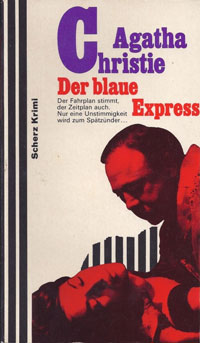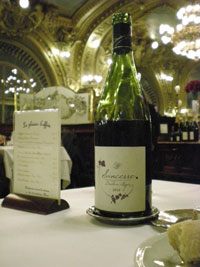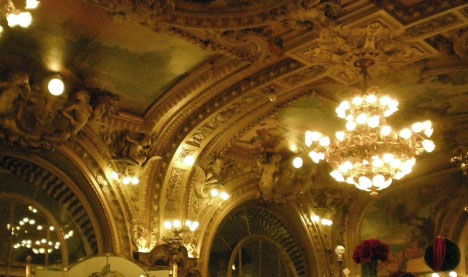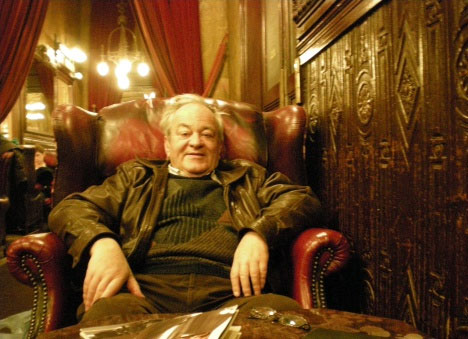
|
| The Blue Train - not only a cult object - also the scene of a murder% that Hercule Poirot can solve. |
The luxury train "Train Bleu" in which the scene is set had the official name "Calais-Mediterranée Express" and once took rich Englishmen directly south to the Mediterranean: "...I want to go to Nice on the fourteenth. I believe there is a train called the 'Blue Express'..." is how Agatha Christie begins a fateful encounter at the Cook travel agency in London. In fact, the famous train with the blue sleeping cars ran between Calais and the French Riviera from 1883 until the Second World War, and again after the war until it was discontinued in 2007. The fast TGV has taken away the customers of the luxurious cult train.
However, a monument to the train has been erected in the Gare de Lyon in Paris. "Train Bleu" is now the name of what is probably the most beautiful station restaurant in Europe and is a reminder of the time when travelling was still associated with luxury - also with good food and drink; of a time when magnificent dining halls were built instead of today's "fast food stalls". In 1900 - just in time for the World's Fair - two new railway stations were opened to traffic in Paris: Gare d'Orsay and Gare de Lyon. Trains have not been running in Orsay for a long time; today it is home to art, especially masterpieces by the Impressionists. In the Gare de Lyon, however, the trains, now modern TGVs, are still lined up and waiting for their journey to the south.

|
| Gare de Lyon. No more Blue Train heading south - but fast TGVs. |
The station buffet of yesteryear, with its 41 paintings from the "BelleÉpoque", has been preserved, beautifully renovated and listed. Here, "haute cuisine" is celebrated daily, still almost in the style of the "Belle Époque", strictly hierarchically ordered, cultivated to the best. The menu and wine list trace the path of the "Blue Train" from north to south (or vice versa). No "nouvelle cuisine", rather typical dishes from different provinces of the country, from fish soup to "tartare de boeuf", from "foie gras de canard cuit maison" to "gigot d'agneau rôti". It is perhaps not the refined top cuisine that one might expect in this unique setting, it is rather the ambience and style in service that dominate here. "The order is taken in writing by one of the 'maîtres d'hôtel', dressed in a black suit. This order is clamped under a small metal plate and fetched by a waiter in a white long apron."

|
| An atmospheric journey through the wine regions of France. |
The wine list also reflects the journey through famous wine regions of France: Alsace, Vallée du Rhône, Bourgogne, Vallée de la Loire, Bordeaux, Languedoc, Champagne...
It is no longer an "insider tip", the "Blue Train" in the Gare de Lyon in Paris. Most guests do not come here to eat particularly good and exclusive food, but to enjoy the atmosphere. Today, anyone who jets to the capital from the "sunny south" by TGV or even by plane can find the lost tranquillity here again. Many of the paintings show landscapes as one could still see them a hundred years ago on the journey from or to the south - along the railway. Instead of floating above the clouds, a "sky of art" spreads out ten metres above the ground in the "Train Bleu", dipped in gold as if this were the universal currency of the "Belle Époque".

|
| The dining room dipped in gold. |
The rapturous pictures, but also the large, richly decorated hall, as well as the serenity with which people eat, drink, serve, even serve and discard here, bring back a piece of travel culture. It is still worthwhile today to travel leisurely, to keep your eyes open and not to haggle over minutes and hours by which you could reach your destination even faster. This includes a good meal, a good wine (from the region), as well as an entertaining travel book. Even "My Friend Maigret", who is sent to the Mediterranean by Georges Simenon in "Train Bleu" to solve a murder on the island of Porquerolles - for once not alone, but accompanied by an inspector from Scotland Yard - takes the night train: "In the corridor of the train they met rich travellers with luxurious luggage. A group of elegantly dressed people with bouquets of flowers on their arms accompanied a film actress to the train. 'It's the Blue Train,' Maigret murmured, as if to apologise."

|
| Comfortable travel in the ambiance of the Blue Train. |
In this detective story, if Maigret adapts himself - as always - to the place of action and drinks a wine from the region, it must be a rosé or white wine; perhaps from the "Domaine de l'île"; perhaps even a wine from the old Rolle grape variety, which is now almost exclusively grown in the south of France: "I am pleased to welcome you, Monsieur Maigret... may I invite you to a glass of our local white wine?... The white wine was well chilled, a little tart, but full of flavour" So a Rolle after all! You won't find it on the wine list of the "Train Bleu", there's no wine from Porquerolles there either. But maybe a clever advertiser will one day come up with the idea of supplementing the offer accordingly, should he one day travel by train instead of by car and have time to read a crime novel by Georges Simenon. Who knows?
Yours sincerely